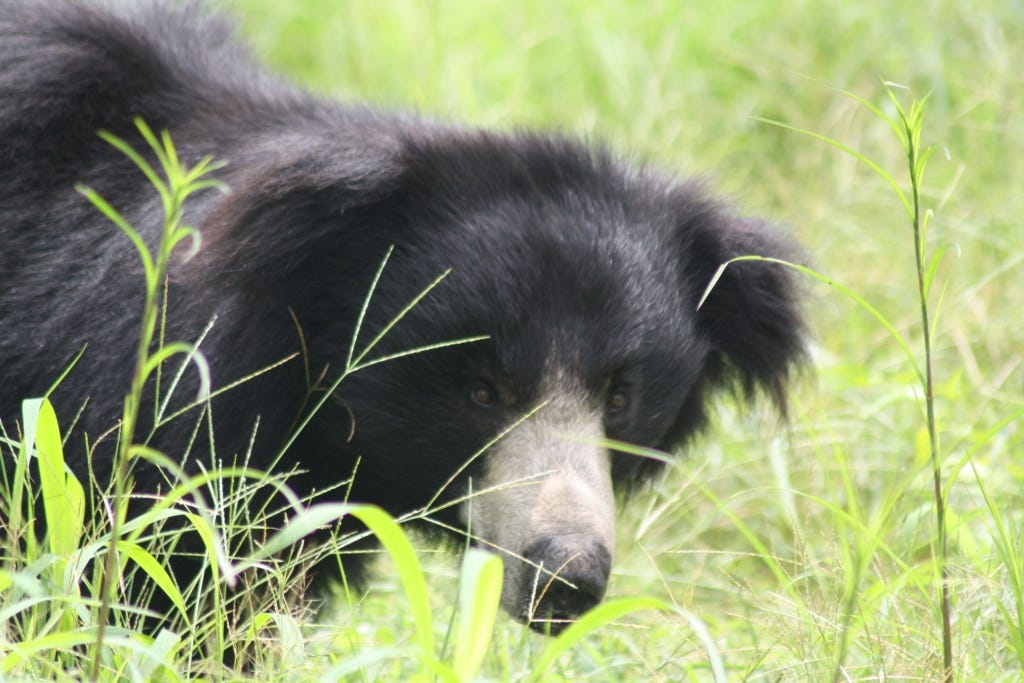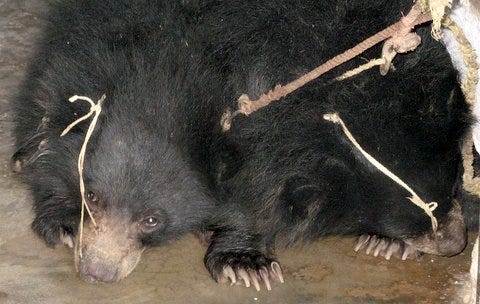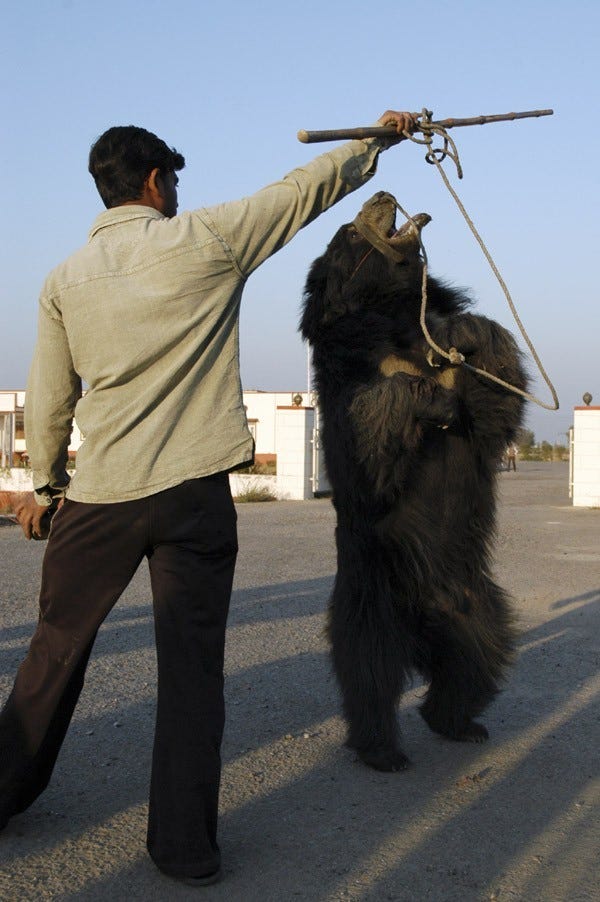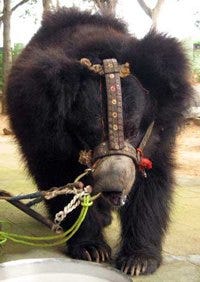Wildlife SOS-India Nearly Extinguishes a 400-Year-Old Practice of Dancing Bears
By Jordan Schaul | National Geographic | October 11, 2012
Contributor Dr. Jordan Schaul interviews colleagues Geeta Seshamani and Kartick Satyanarayan, the founders of Wildlife SOS-India, and Nikki Sharp, Executive Director of Wildlife SOS-USA. The bear conservationists reflect on how they are putting an end to the 400-year-old practice of dancing bears in an exclusive Skype interview across the world.
Below is the story of the Wildlife SOS and the Agra Bear Rescue Facility—a welfare and conservation success story based on a holistic approach to ending the cruel practice of Dancing Bears in India.
The sloth bear (Melursis ursinus) is unique to the Indian Subcontinent and numbers near 10,000 in the wild. A species of conservation concern, sloth bear numbers are decreasing in the wild due to an array of anthropogenic factors. Fortunately, this extraordinary-looking bear has one less human threat to worry about as pressures associated with the exploitative practice of dancing bears have been suppressed, if not eradicated across India.
For over four hundred years, the Kalandars—a nomadic tribal community of Muslim gypsies—had used the sloth bear for Bear Dancing to entertain. Initially intended to entertain emperors and royalty, dancing bear acts have more recently been performed for the entertainment of tourists and the rural public.
Interview:
Jordan: Can you tell us how you learned the extent to which this barbaric practice of dancing bears was discovered in the Republic of India, which by the way is the second most populated democracy on the planet?
Geeta: In 1995, we conducted an investigative study, which was published two years later. The report expressed concern that a much larger number of sloth bears were held in captivity than had been imagined (over 1200 were physically verified by the investigators), and annually it was estimated over 200 bear cubs were poached to supply the demand created by the Kalandars of which less than one third survived to reach the Kalandars for training. The cubs had a high mortality due to the brutality of handling, transportation stress, aggravated by the use of opium to keep the animals quiet in sacks or baskets, while smuggling them in trains and buses to the markets. Due to a complete lack of veterinary attention, knowledge of nutrition or management, more than fifty percent of the animals died in the first three years due to leptospirosis, rabies, infectious canine hepatitis, and tuberculosis in the hands of the Kalandars.
Jordan: Dancing bears is more than just an animal welfare concern—the practice has implications for the conservation of the species?
Kartick: This demand for bear cubs caused by the practice of Dancing Bears used by the Kalandars posed a very real and serious threat to the wild sloth bear population in India. The Wildlife SOS study also exposed the brutal training practices of the Kalandars: the knocking out of the teeth with metal rods; the piercing of the muzzle with a red hot iron needle through which a rope was passed; the castration with a blade sans anesthesia; and subsequent beatings. In fact, the only instruments of training were fear and pain.
Jordan: What did you do to begin to combat the problem?
Geeta: Since the advent of the Wildlife Protection Act in 1972, the possession and dancing of sloth bears (protected under schedule 1 of the Act) had become illegal and punishable by law.
Wildlife SOS approached the Ministry of Environment and Forests, Government. of India with a proposal to establish as a critical first step to implementing the Law—the first Sloth Bear Rescue and Rehabilitation Centre in Agra. With the cooperation of the Uttar Pradesh Forest Department, Wildlife SOS established the Agra Bear Rescue Facility. This was the beginning of the end! A great Government and NGO partnership were born. Today, the ‘Agra Bear Rescue Facility’ is globally the largest rescue center for rescued sloth bears, housing over 270 rescued bears on about 160 acres of land allotted to the project by the Uttar Pradesh Government. The organizations involved in establishing the Agra Bear Rescue Facility and which continue to support it are IAR, FTB and One Voice.
Jordan: What is also remarkable is what you did to rehabilitate the Kalandar people. Can you explain?
Kartick: Through an intensive process of engaging with the Kalandar community and living with them in over 60 villages, a relationship of trust was built up between them and the founders of Wildlife SOS. Once convinced, the Kalandars agreed to voluntarily hand over their bears held by them in illegal custody and in turn accept from Wildlife SOS skill training and one-time seed funds to establish themselves in alternate livelihoods that would improve their quality of life.
Geeta: This community rehabilitation was a complex task and initially we experienced a lot of resistance from the community due to their poverty, their lack of education, health care, and proper housing.
The skill training provided by Wildlife SOS to the Kalandars involved carpet weaving, driving, welding, grinding and packaging spices, sewing, jewelry-making, gem cutting, and polishing, running tea shops, vending vegetables and goods, etc., were just some of the professions chosen by the Kalandars.
Jordan: How many Kalandars have been rehabilitated?
Kartick: More than 3000 Kalandar families have benefitted from this program across India. Kalandar women empowerment projects launched by Wildlife SOS made them second income earners for the family giving the women more respect and a larger say in family matters. Wildlife SOS micro-funded small ventures chosen by them such as selling plastic goods or bangles and cosmetics or rearing poultry and stitching chappals, embroidering wedding sarees, cutting leather for cricket balls. Wildlife SOS also supports the education of Kalandar children by sponsoring school fees, books, uniforms, etc so the children would find it easier to integrate with mainstream society and move away from Bear Dancing.
Jordan: Can you explain how we continue to monitor activities to ensure that the practice of dancing bears remains suppressed?
Kartick: Wildlife SOS’s anti-poaching unit called Forestwatch works in collaboration with Police and Forest Departments across India with a network of informers to track bear cub poachers, middle men and traders to control bear cub poaching. Over 70 bear cubs have been rescued from poachers to date
Jordan: We also do outreach through the Agra facility, correct?
Nikki: Correct! The Agra Bear Rescue Facility also functions as a training, education, and awareness platform, where Wildlife SOS conducts programs, workshops, and lectures for enforcement officers and students. Premier institutions such as the Wildlife Institute of India, Indira Gandhi National Forest Academy, Forest Research Institute, etc. send their trainees on field visits. Veterinary students from all over the world come to study the veterinary procedures and management techniques at the Agra Bear Rescue Facility where extensive research on bear behavior and veterinary aspects goes on all year round.
ABOUT NATIONAL GEOGRAPHIC SOCIETY
The National Geographic Society is a global nonprofit organization that uses the power of science, exploration, education and storytelling to illuminate and protect the wonder of our world. Since 1888, National Geographic has pushed the boundaries of exploration, investing in bold people and transformative ideas, providing more than 14,000 grants for work across all seven continents, reaching 3 million students each year through education offerings, and engaging audiences around the globe through signature experiences, stories and content. To learn more, visit www.nationalgeographic.org or follow us on Instagram, Twitter and Facebook.
MEET THE AUTHOR
Jordan Carlton SchaulWith training in wildlife ecology, conservation medicine, and comparative psychology, Dr. Schaul's contributions to Nat Geo Voices have covered a range of environmental and social topics. He draws particular attention to the plight of imperiled species highlighting issues at the juncture or nexus of sorta situ wildlife conservation and applied animal welfare. Sorta situ conservation practices are comprised of scientific management and stewardship of animal populations ex situ (in captivity / 'in human care') and in situ (free-ranging / 'in nature'). He also has a background in behavior management and training of companion animals and captive wildlife, as well as conservation marketing and digital publicity. Jordan has shared interviews with colleagues and public figures, as well as editorial news content. In addition, he has posted narratives describing his own work, which include the following examples: • Restoration of wood bison to the Interior of Alaska while (As Animal Curator at Alaska Wildlife Conservation Center and courtesy professor at the University of Alaska) • Rehabilitation of orphaned sloth bears exploited for tourists in South Asia (While executive consultant 'in-residence' at the Agra Bear Rescue Center managed by Wildlife SOS) • Censusing small wild cat (e.g. ocelot and margay) populations in the montane cloud forests of Costa Rica for popular publications with 'The Cat Whisperer' Mieshelle Nagelschneider • Evaluating the impact of ecotourism on marine mammal population stability and welfare off the coast of Mexico's Sea of Cortez (With Boston University's marine science program) Jordan was a director on boards of non-profit wildlife conservation organizations serving nations in Africa, North and South America and Southeast Asia. He is also a consultant to a human-wildlife conflict mitigation organization in the Pacific Northwest. Following animal curatorships in Alaska and California, he served as a charter board member of a zoo advocacy and outreach organization and later as its executive director. Jordan was a member of the Communication and Education Commission of the International Union for the Conservation of Nature (CEC-IUCN) and the Bear Specialist Group of the IUCN Species Survival Commission (BSG-SSC-IUCN). He has served on the advisory council of the National Wildlife Humane Society and in service to the Bear Taxon Advisory Group of the Association of Zoos and Aquariums (AZA Bear TAG). In addition, he was an ex officio member of the council of the International Association for Bear Research and Management.







